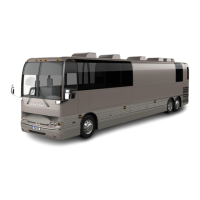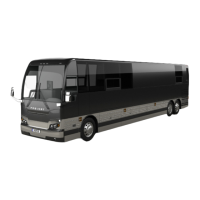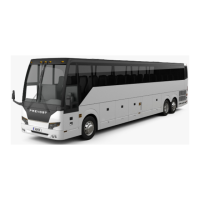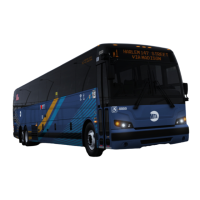Other Features 69
LOW-BUOY
This system lowers the coach about 4 inches
(100 mm). It enables the coach to drive through
underpasses where the height is less than 12
feet (3.7 m).
Low-Buoy operation is controlled by a valve
located on the right lateral console. The valve
can be switched to either LOW-BUOY or
NORMAL positions. A warning light on the
dashboard will indicate that the coach is being
lowered. Refer to "Controls & Instruments"
chapter.
CAUTION
Avoid parking too close to the curb or other
obstacles that could damage the coach during
low-buoy operation.
NOTE
The Low-Buoy system does not operate when
the coach is traveling over 5 mph (8 km/h).
Consequently, the driver cannot inadvertently
operate the Low-Buoy system at higher
speeds.
UNLOADING TAG AXLE
To reduce the turning radius, the air springs
pressure will be automatically reduced by 75%
when the coach is moving at speed lower than 5
mph (8 km/h) and with more than 1½ turn from
the steering.
RETRACTABLE TAG AXLE
The standard tag axle retraction system is
controlled by a valve located on the right lateral
console. The valve can be switched to either
the WHEELS UP or WHEELS DOWN position.
The axle will be raised or lowered by air
pressure according to the valve position. Refer
to "Controls & Instruments" chapter.
The tag axle service brakes operate only when
the tag axle is in the WHEELS DOWN position.
When the tag axle is in the WHEELS UP
position, the corresponding indicator light will
illuminate and a beep will sound to alert the
driver of the tag axle's position. The tag axle
can be raised in tight maneuvering areas like in
a parking lot or to make it easier to turn a short
corner. The tag axle shortens the wheelbase
and allows tighter turning. Raising the tag axle
transfers extra weight and additional traction to
the drive wheels providing improved control on
slippery roads.
CAUTION
Do not use tag axle in raised position for an
extended period. Raising tag axle increases
load on the drive axle, suspension and tires.
Do not drive vehicle with tag axle raised when
speed is exceeding 9mph (15 km/h).
In order to prevent damage to the suspension,
always raise the tag axle before lifting the
coach.
IN-STATION LIGHTING
The in-station lighting system circuit is linked
with the optional battery charger: When the
charger is connected to an external power
source, the in-station lighting circuit can be
energized without depleting the batteries.
The receptacle used for the battery charger is
located on the main power compartment door.
COOLANT HEATER
This optional auxiliary heating system is used for
preheating and retaining the heat of water-
cooled engines. It can be used before startup to
ease starting and to provide rapid operation of
the interior heating system. It can also be used
with the engine running to maintain coolant heat
and interior temperature.
The heater operates independently of the
engine. It is connected to the cooling system,
heating circuits and to the vehicle’s fuel and
electrical system.
WARNING
The coolant heating system uses the same
fuel as the engine. Do not operate in a closed
building or while refueling. Operate only in a
well ventilated area.
SWITCHING THE HEATER ON
The timer light illuminates when the heater is
switched ON. Air is forced in to flush out the
combustion chamber of residual gases and the
water circulation pump begins operating. The
fuel metering pump delivers fuel in precise
amounts to the combustion chamber, where fuel
and combustion air form a combustible mixture
which is ignited by the ignition unit.
Once the flame sensor has signaled to the
control unit that combustion has taken place, the
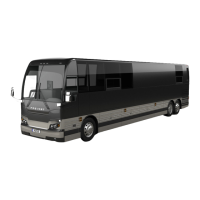
